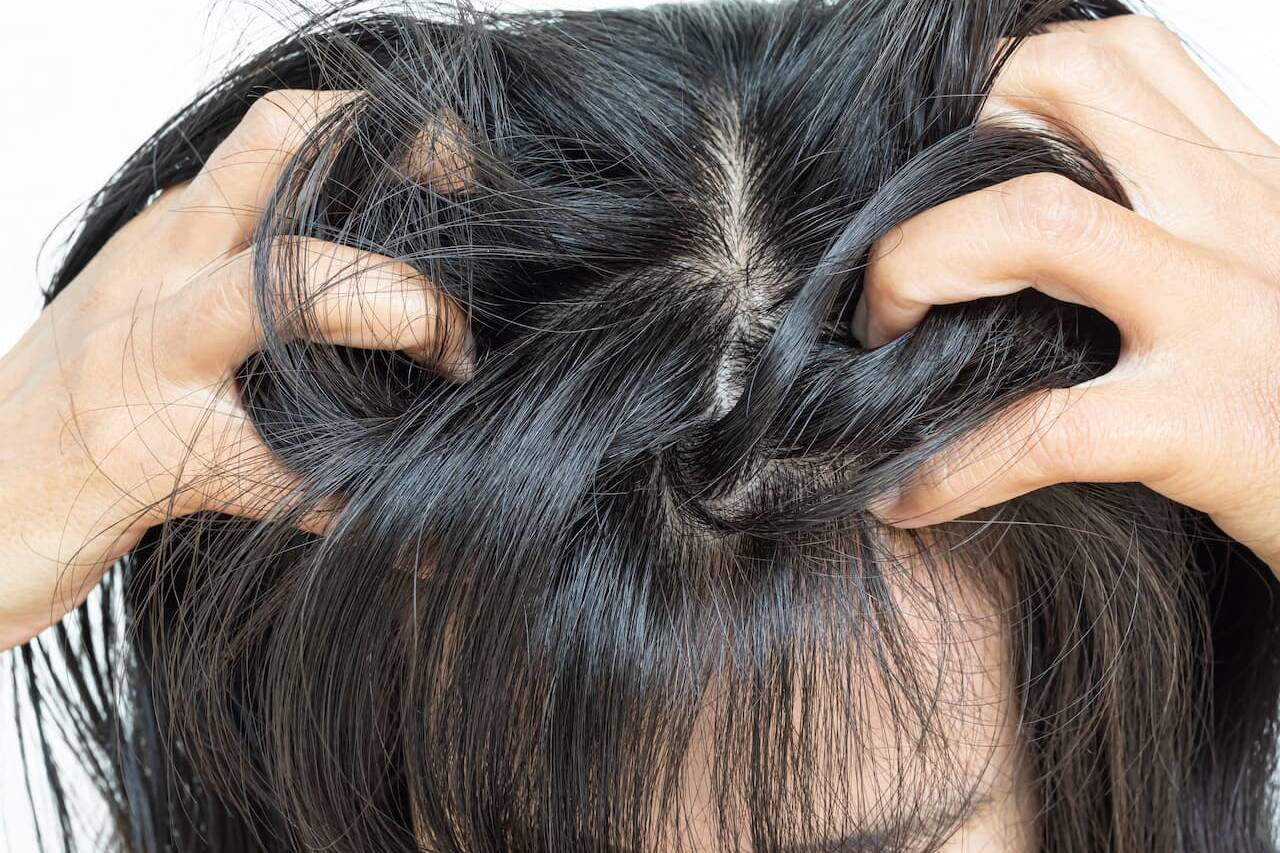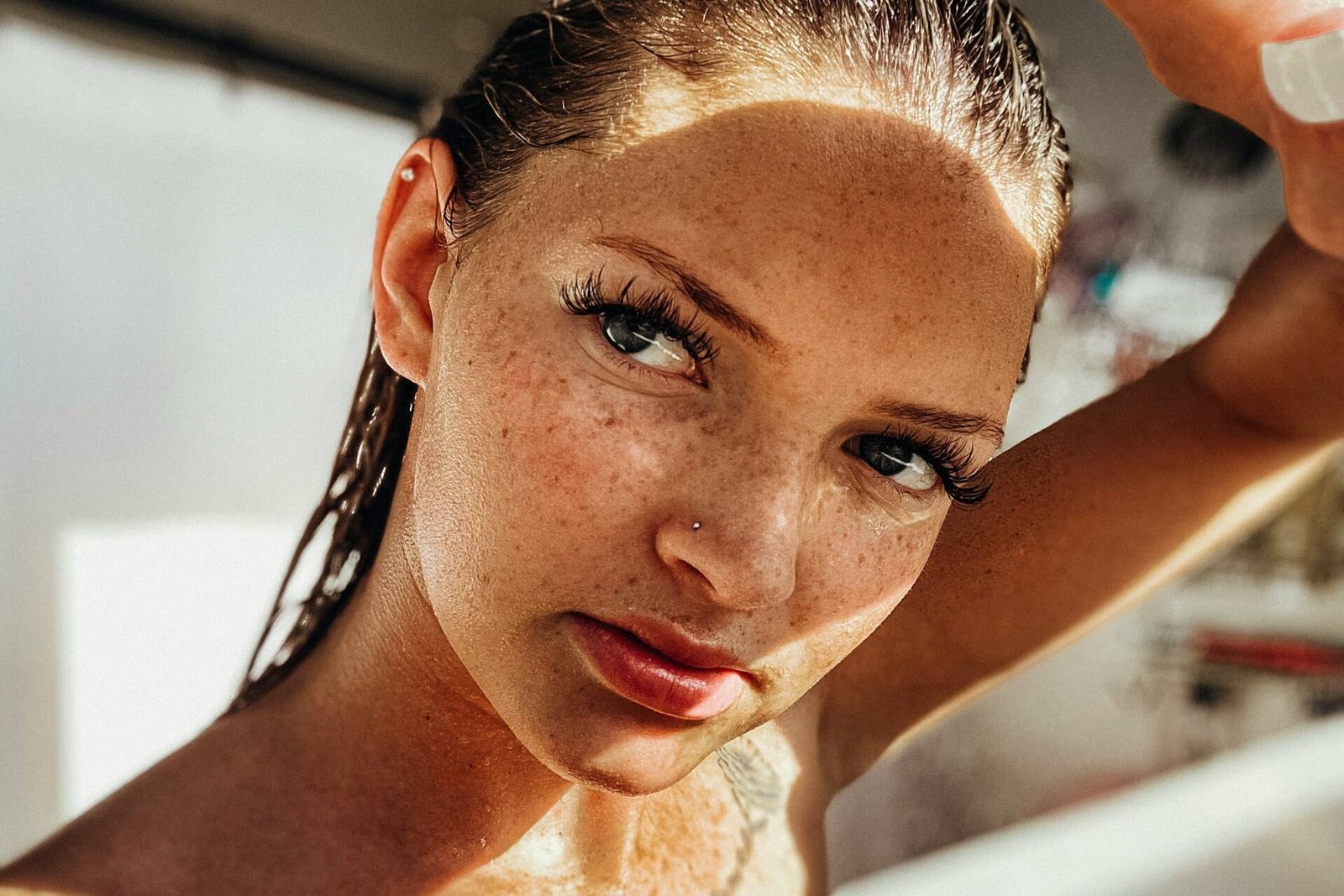How Often Should You Actually Wash Different Types of Coloured Hair?
The ideal washing frequency varies significantly depending on your hair colour, texture, and scalp condition. Here’s a research-backed guide:
For Vibrant Reds, Purples, and Fashion Colours
Ideal washing frequency: 1-2 times per week maximum
Why: Research from the Journal of the Society of Cosmetic Chemists found that red dyes contain larger colour molecules that sit more loosely in the hair shaft and can be lost up to 40% faster than other colours.
Professional tip: “Red and fashion colours benefit tremendously from ‘co-washing’ or using cleansing conditioners between regular washes,” says Master Colourist Emma Davies. “This provides light cleansing without opening the cuticle fully, preserving those larger colour molecules.”
For Highlighted or Balayaged Hair
Ideal washing frequency: 2-3 times per week
Why: Lightened hair has a more porous structure, which makes it vulnerable to both colour loss and unwanted tone shifts (like brassiness or dullness).
Professional tip: “For highlighted hair, focus your washing energy on the scalp only, allowing the shampoo to gently flow through the ends during rinsing instead of scrubbing the lengths,” recommends Senior Colourist Thomas Chen.
For All-Over Brunettes and Dark Colours
Ideal washing frequency: 3-4 times per week if needed
Why: Darker dyes typically use smaller colour molecules that penetrate deeper into the hair shaft, making them somewhat more resistant to washing. However, they can develop unwanted warmth when exposed to too many washing cycles.
Professional tip: “Brunettes should focus on colour-preserving shampoos with low pH, like Colour Saviour Shampoo, which keeps the cuticle tight and prevents the underlying warm pigments from emerging,” advises Celebrity Colourist Maria Lopez.
For Grey Coverage and White Blondes
Ideal washing frequency: 2-3 times per week with purple/blue shampoo once weekly
Why: These colours are highly susceptible to environmental yellowing and product buildup that can dull their appearance.
Professional tip: “For grey coverage and platinum blondes, product selection is critical. Use a gentle, sulphate-free cleanser like Colour Saviour for most washes, saving intensive toning shampoos for once weekly use to prevent over-depositing,” suggests Colour Correction Specialist David Wong.
The Step-by-Step Proper Washing Technique
How you wash your coloured hair is just as important as what you wash it with. Follow this colourist-approved technique:
Step 1: Pre-Wash Preparation (Often Skipped!)
Before your hair even gets wet, gently dry-brush to remove tangles and distribute natural oils from root to tip. This creates a light protective coating that reduces colour loss during washing.
Step 2: The Crucial Pre-Soak
Thoroughly saturate your hair with lukewarm water for at least 60 seconds before applying any shampoo. Research shows pre-soaked hair absorbs less shampoo (and loses less colour) than hair that’s quickly wetted.
Step 3: Dilution Is the Solution
Place a 10p-sized amount of gentle, colour-safe shampoo like Colour Saviour into your palm, then add a few drops of water to dilute it slightly before applying. This creates a gentler cleansing experience while still removing buildup.
Step 4: Scalp Focus, Not Length
Apply shampoo primarily to your scalp using fingertips (not nails) in gentle circular motions. The goal is to cleanse the scalp where oil builds up while minimizing direct detergent contact with the coloured lengths.
Step 5: The Correct Rinse Technique
Rinse with cool water for at least 60-90 seconds, ensuring all product is removed. Research from the International Journal of Trichology found that inadequate rinsing leaves residue that attracts dirt and dulls colour faster.
Step 6: Condition Strategically
Apply conditioner from mid-lengths to ends only, avoiding the scalp. Allow it to remain on hair for 2-3 minutes before rinsing with the coolest water you can tolerate to seal the cuticle completely.
Temperature Matters: The Science of Cool Water Washing
That steamy hot shower might feel wonderful, but it’s terrible for your hair colour. Here’s why temperature is perhaps the most crucial factor in colour preservation:
The Cuticle Response to Temperature
Your hair’s outer layer—the cuticle—consists of overlapping scales that respond directly to temperature changes. When exposed to hot water (above 38°C/100°F), these scales lift and separate, creating pathways for colour molecules to escape.
The Research Evidence
A landmark study in the Journal of Cosmetic Science measured colour loss in hair washed at different temperatures and found:
- Hair washed at 43°C (110°F) lost colour 26% faster than hair washed at 24°C (75°F)
- Each 5°C increase in water temperature accelerated colour fading by roughly 5-8%
- Cool water washing extended colour vibrancy by an average of 4 weeks compared to hot water washing
The Compromise Solution
Since many people can’t tolerate truly cold showers, colourists recommend:
- Wash your hair separately from your body shower using cooler water
- Install an inexpensive shower thermometer to ensure water stays below 38°C
- At minimum, do your final rinse with cool water to close the cuticle
The Professional Secret
“In the salon, we always use water between 24-27°C for our colour clients’ final rinse,” reveals Senior Colourist Jessica Murray. “It’s a small discomfort for significant colour preservation benefits.”
Ingredients That Actually Protect Colour During Washing
Not all “colour-safe” products are created equal. Research shows these specific ingredients provide measurable colour protection during washing:
Betaine: The Gentle Cleanser
Derived from sugar beets, betaine offers cleansing power without stripping colour. Research published in the International Journal of Cosmetic Science demonstrated that shampoos containing betaine as a primary surfactant caused 17% less colour fade than conventional surfactant systems.
Colour Saviour Shampoo harnesses the power of betaine to effectively cleanse without compromising your colour investment.
Wheat Protein: The Cuticle Sealer
Hydrolyzed wheat protein creates a temporary seal over damaged areas of the hair cuticle, preventing colour molecules from escaping during washing. A 2021 study found that wheat protein-based formulas reduced colour loss by up to 25% over 12 washes.
Look for this ingredient near the top of your product’s ingredient list, as found in Colour Saviour’s gentle formulation.
Aloe Juice: The Natural Protector
Beyond its soothing reputation, aloe vera juice contains polysaccharides that coat the hair shaft, creating a protective barrier that helps lock in colour molecules. It also helps maintain optimal moisture levels that keep colour looking vibrant rather than dull.
Colour Saviour Shampoo uses aloe juice as its primary base rather than water, maximizing this protective benefit.
What to Strictly Avoid
Research conclusively shows these ingredients accelerate colour fading:
- Sodium Lauryl Sulfate (SLS) and Ammonium Lauryl Sulfate (ALS)
- Sodium Chloride (salt) in high concentrations
- Alcohol (denat.) high on the ingredient list
- High alkalinity formulas (pH above 6.0)
Common Washing Myths: Debunked by Expert Colourists
Let’s separate fact from fiction when it comes to washing coloured hair:
MYTH: “Sulphate-free” automatically means colour-safe
THE TRUTH: While avoiding sulphates is important, some sulphate-free formulas use alternative detergents that can be equally stripping. Look for gentle surfactants like coco-glucoside and betaine (as found in Colour Saviour Shampoo) rather than just the “sulphate-free” claim.
MYTH: You should never use clarifying shampoos on coloured hair
THE TRUTH: Controlled clarifying (every 4-6 weeks) can actually improve colour retention by removing mineral deposits that dull hair and distort colour. The key is following with an intensive colour-protecting mask.
MYTH: Cold water “locks in” hair colour permanently
THE TRUTH: While cooler water absolutely reduces colour fade by keeping the cuticle closed, the effect is temporary. Each wash will still cause some colour loss, just at a slower rate. Consistent cool water washing extends colour life but doesn’t permanently seal it.
MYTH: You can train your scalp to produce less oil by washing less
THE TRUTH: “There’s limited scientific evidence supporting the concept of ‘training’ your scalp,” explains Trichologist Dr. Lauren Miller. “Sebum production is primarily determined by hormones, genetics, and health—not washing frequency. Instead, focus on gentle, non-stripping cleansers that maintain scalp health without compromising colour.”
Colour-Specific Washing Guide
Different hair colours have unique washing requirements. Here’s your colour-specific guide:
For Red and Copper Tones
Key challenge: Fastest fading of all colours due to large molecule size
Specialized technique:
- Pre-treat with colour-locking spray before washing
- Use cool water only (never warm)
- Consider diluting your colour-safe shampoo with water (1:1 ratio)
- Incorporate a weekly colour-depositing conditioning mask
Product recommendation: Gentle, pH-balanced formulas like Colour Saviour Shampoo prevent the premature erosion of those vulnerable red molecules.
For Blonde and Silver Tones
Key challenge: Environmental yellowing and porosity issues
Specialized technique:
- Pre-treat with filtered water if in hard water areas
- Use regular colour-safe shampoo for most washes
- Use toning/purple shampoo only once weekly (over-use causes dryness and dulling)
- Ensure complete rinsing to prevent product buildup
Product recommendation: Colour Saviour’s wheat protein helps temporarily seal porous areas where unwanted yellow tones can develop.
For Dark Brunettes
Key challenge: Unwanted warmth emerging over time
Specialized technique:
- Focus on low-pH products to keep the cuticle tightly closed
- Minimize heat styling, which speeds up colour molecule degradation
- Use a weekly gloss treatment to maintain richness
- Consider cool water rinsing non-negotiable
Product recommendation: Colour Saviour’s acidic pH formula helps keep unwanted warm undertones from surfacing in dark colours.
For Fashion Colours (Blues, Pinks, Purples)
Key challenge: Rapid fading and uneven colour release
Specialized technique:
- Wash hair with conditioner only (co-wash) for at least 50% of your washes
- When using shampoo, dilute it significantly
- Consider using shower caps and extending time between washes
- Use leave-in products with UV protection daily
Product recommendation: When shampooing is necessary, ultra-gentle cleansers like Colour Saviour preserve these delicate pigments.
Your Coloured Hair Washing FAQ
How soon after colouring can I wash my hair?
Expert answer: Ideally, wait 48-72 hours before your first wash. Modern hair dyes continue to develop after application, and this waiting period allows the colour molecules to fully bind within the hair shaft. If absolutely necessary, a gentle cleanse with Colour Saviour after 24 hours is acceptable, but never sooner.
Does hard water really affect my colour that much?
Expert answer: Absolutely. Research shows that minerals in hard water (calcium, magnesium, and iron) can both fade existing colour and prevent new colour from adhering properly. A shower filter can reduce mineral exposure by 70-80%, significantly extending colour life.
Should I use colour-depositing shampoos for regular washing?
Expert answer: No. While colour-depositing products have their place, they can build up on the hair, creating dullness and uneven colour. Reserve them for occasional use (once weekly maximum) and rely on gentle, non-depositing formulas like Colour Saviour for regular cleansing.
Why does my blonde hair turn brassy even with purple shampoo?
Expert answer: Purple shampoo addresses yellowing but not orange tones (which require blue pigment). More importantly, most purple shampoos don’t address the underlying causes of brassiness: mineral deposits, hard water, and high-pH cleansers. Focus on using a gentle, pH-balanced shampoo for most washes to prevent brassiness from developing in the first place.
I have oily hair but coloured ends—how should I wash?
Expert answer: This common combination requires a dual approach. Focus a gentle, colour-safe cleanser like Colour Saviour directly on the scalp to manage oil, while minimizing contact with your coloured lengths. Consider using a scalp-specific treatment once weekly to regulate oil production while preserving your colour investment.
Proper washing technique is the foundation of colour longevity. By adjusting your routine based on these expert recommendations, you can dramatically extend the life of your colour investment—turning what might have been 4 weeks of vibrant colour into 8 or even 12 weeks of head-turning brilliance.
What coloured hair washing questions do you still have? Share in the comments below, and our colour experts will provide personalized advice!
Related Articles
June 29, 2025
The Complete Guide to Post-Workout Hair Washing
Why Most People Are Washing Their Hair Wrong? You've invested time in…
June 7, 2025
How to Tell If You Have a Sensitive Scalp: 7 Warning Signs You Shouldn’t Ignore
Does your scalp feel uncomfortable after washing your hair? Do certain products…
May 17, 2025
Why Your Water Quality Might Be Sabotaging Your Hair Shine (And What to Do About It)
Is your shower secretly stealing your hair's shine? The water flowing through…



